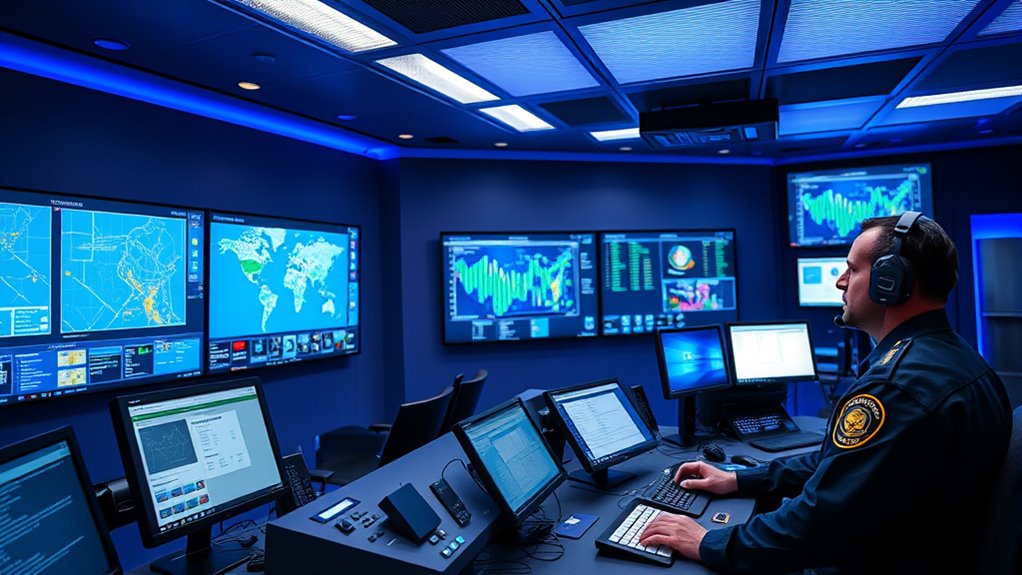Modern E‑911 systems speed up response times by using advanced technology like GPS, Wi-Fi, and cell tower data to pinpoint your location accurately. Integrated systems facilitate real-time data sharing among emergency responders, enabling quicker coordination and decision-making. Automated call handling and smart routing direct your call to the right team instantly. These innovations combine to reduce delays and improve overall emergency responses. Explore further to discover how these technologies are shaping faster, more reliable aid during crises.
Key Takeaways
- Enhanced location accuracy via GPS, Wi-Fi, and cell tower data reduces response times and directs help precisely.
- Real-time data sharing and interoperability enable quick, seamless communication between emergency systems.
- Automated call routing and handling streamline the process, minimizing delays and manual errors.
- Advanced mapping and GIS integration provide accurate incident visualization, speeding up response decisions.
- Predictive analytics and IoT data help anticipate emergencies and optimize resource deployment for faster responses.
The Evolution of Emergency Communication Systems

Emergency communication systems have come a long way from traditional landline calls to more advanced digital solutions. This evolution enhances disaster preparedness by enabling faster, more reliable alerts to the public. As technology advances, public awareness about emergency procedures increases, helping communities respond more effectively. Modern systems now incorporate features like mobile alerts, social media integration, and real-time updates, ensuring that essential information reaches people quickly. These improvements allow you to stay informed during crises, making it easier to take appropriate action. The shift from basic landlines to sophisticated digital platforms has transformed emergency response, emphasizing the importance of proactive communication in saving lives. Additionally, incorporating high-precision alerting technology into these systems can significantly reduce response times and improve coordination during emergencies. Staying updated on these advancements helps you and your community better prepare for unforeseen disasters.
Key Technologies Behind E‑911 Integration

The modern capabilities of E‑911 systems rely on a range of advanced technologies working seamlessly together. These innovations guarantee rapid, accurate responses. Key technologies include:
- Enhanced Location Accuracy: Using GPS, Wi-Fi, and cell tower data, systems pinpoint your location precisely, reducing response times.
- Data Interoperability: Networks seamlessly exchange information between disparate systems, ensuring dispatchers receive comprehensive, real-time data.
- Advanced Mapping Software: Integrates location data with geographic information systems (GIS) to visualize incident sites accurately and swiftly.
Together, these technologies improve the speed and precision of emergency responses, making sure help arrives where it’s needed most, faster than ever before.
How Integrated Systems Improve Response Efficiency

Integrated systems streamline the response process by enabling real-time data sharing and coordination among dispatch centers, first responders, and emergency services. With efficient call routing, your system quickly directs calls to the appropriate responders based on location and severity, reducing delays. Data interoperability guarantees that critical information—such as caller details, incident type, and location—is shared instantly across platforms, eliminating data silos. This seamless flow of information allows responders to prepare before arriving, improving response times and decision-making. By automating call handling and ensuring accurate data exchange, integrated systems minimize manual errors and cut down on unnecessary steps. Additionally, leveraging predictive analytics can help anticipate potential emergencies and allocate resources proactively, further enhancing response efficiency. Ultimately, your ability to coordinate swiftly and accurately saves lives and enhances the overall effectiveness of emergency responses.
Challenges and Solutions in Modern E‑911 Deployment

Deploying modern E‑911 systems presents several challenges, including technological complexity, funding constraints, and ensuring interoperability across diverse platforms. To overcome these, you can focus on:
- Integrating call center automation to streamline call handling and reduce response times.
- Leveraging public safety analytics to identify patterns, improve resource allocation, and enhance decision-making.
- Ensuring compatibility between legacy systems and new technology to create a seamless, unified emergency response network.
Addressing these challenges requires strategic planning and investment. By adopting advanced tools like call center automation and public safety analytics, you can improve system efficiency and reliability. This approach not only speeds up response times but also enhances overall public safety, making your E‑911 deployment more effective.
The Future of Emergency Response Technology

Advancements in emergency response technology are rapidly transforming how agencies detect, communicate, and coordinate during crises. In the future, smart city infrastructure will integrate sensors, cameras, and IoT devices to provide real-time data, giving you faster insights during emergencies. Data analytics will play a critical role, helping you analyze vast amounts of information quickly to identify patterns and predict incidents before they escalate. This proactive approach will enable faster decision-making and resource deployment. You’ll see improvements in automated alerts, integrated communication platforms, and enhanced GIS mapping, all working seamlessly to speed up response times. As technology evolves, emergency systems will become more interconnected, making your response efforts more efficient and effective in saving lives and minimizing damage. Additionally, implementing mental health support within emergency protocols can improve overall response effectiveness by addressing emotional and psychological needs during crises.
Frequently Asked Questions
How Do Privacy Concerns Impact E‑911 System Integration?
Privacy concerns impact E‑911 system integration because you need to protect sensitive data, which involves implementing data encryption to secure caller information. You also must manage consent carefully, ensuring users agree to share their location and personal details. These measures can slow down the integration process but are essential for maintaining trust and complying with privacy laws, ultimately balancing quick emergency responses with safeguarding individuals’ privacy rights.
What Training Is Required for Emergency Responders on New Systems?
Coincidentally, when you learn about new systems, you realize that emergency responder certification and system training protocols are essential. You’ll undergo specialized training sessions that cover operational procedures, system functionalities, and troubleshooting. This guarantees you’re confident handling modern emergency response tools. The training emphasizes quick adaptation, so you’re prepared to use the latest technology effectively, ultimately speeding up response times and improving overall public safety.
How Do Rural Areas Benefit From E‑911 Advancements?
Rural areas benefit from E‑911 advancements by improving rural connectivity, ensuring emergency calls are accurately located and promptly routed. These systems enable faster response times, even in remote locations. Plus, community outreach programs educate residents about new features, increasing awareness and readiness. You’ll notice quicker assistance, better communication, and stronger ties between responders and your community, making rural safety more effective and reliable.
What Funding Options Are Available for Upgrading Emergency Systems?
You can access various funding options like grant programs and public-private partnerships to upgrade emergency systems. Grants often come from federal, state, or local governments aiming to improve public safety. Public-private partnerships enable collaboration with private entities to share costs and expertise. These options help you modernize your emergency infrastructure, ensuring faster response times and better service, especially in underserved areas. Exploring these avenues can make upgrading more feasible and sustainable.
How Is Data Security Maintained in Integrated Emergency Networks?
Did you know that over 90% of data breaches involve weak security measures? In integrated emergency networks, you play a critical role in maintaining data security by guaranteeing encryption protocols are up-to-date and robust. You also use strict access controls to limit who can see sensitive information. These measures protect essential data, prevent unauthorized access, and make sure that emergency response systems remain reliable and secure when every second counts.
Conclusion
By embracing modern E‑911 integration, you can substantially speed up emergency responses and save lives. Some might worry about costs or complexity, but the benefits far outweigh the challenges. Investing in these advanced systems ensures you’re prepared for any situation, providing faster, more accurate assistance when it matters most. Ultimately, staying ahead with technology isn’t just about efficiency — it’s about truly protecting your community and those you serve.








